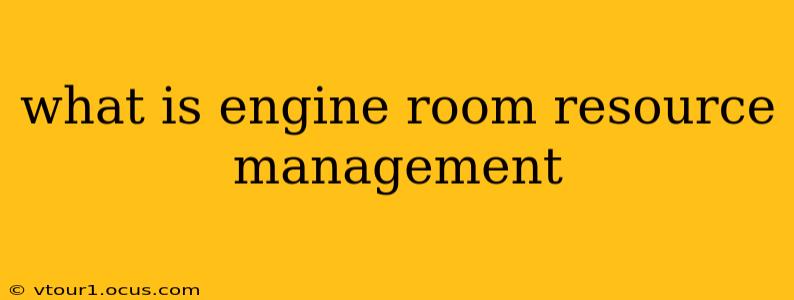Engine Room Resource Management (ERRM) is a crucial system of managing resources – human, material, and time – within a ship's engine room to ensure safe, efficient, and effective operation. It's not just about fixing problems; it's a proactive approach to preventing them and responding effectively when they arise. Think of it as the engine room's equivalent of a well-oiled machine, where every component works in harmony to achieve a common goal. It’s a critical element of overall ship management and directly impacts safety, efficiency, and the bottom line.
What are the Key Elements of ERRM?
Effective ERRM relies on several interconnected elements:
1. Teamwork and Communication:
- Clear Roles and Responsibilities: Each member of the engine room crew must understand their specific duties and how they contribute to the overall operation. This includes clear lines of communication and reporting structures.
- Effective Communication: Open, honest, and timely communication is vital. This means using clear and concise language, active listening, and utilizing various communication methods appropriately (e.g., verbal, written, visual). This avoids misunderstandings and ensures everyone is on the same page.
- Shared Situational Awareness: Every member should have a good understanding of the overall state of the engine room, the tasks underway, and any potential problems. Regular briefings and updates are essential.
2. Risk Assessment and Management:
- Proactive Hazard Identification: Regularly identifying potential hazards in the engine room is essential. This includes evaluating machinery, processes, and working conditions.
- Risk Mitigation Strategies: Implementing procedures and controls to reduce identified risks is crucial. This could involve modifying tasks, improving equipment, or enhancing safety training.
- Incident Reporting and Analysis: Tracking incidents, conducting root cause analyses, and implementing corrective actions prevents future occurrences.
3. Planning and Prioritization:
- Effective Planning: Tasks should be planned efficiently to optimize workflow and prevent bottlenecks. This includes considering resources, time constraints, and potential interruptions.
- Prioritization of Tasks: Determining which tasks are most critical and assigning them accordingly is crucial, especially in emergency situations.
- Resource Allocation: Effectively allocating available resources (personnel, tools, materials) to the highest priority tasks ensures optimal efficiency.
4. Standard Operating Procedures (SOPs):
- Clear and Concise Procedures: Having well-defined SOPs for all routine tasks and emergency situations helps ensure consistency, safety, and efficiency.
- Regular Review and Updates: SOPs should be reviewed and updated regularly to reflect changes in technology, regulations, and best practices.
- Training and Competency: Crew members must be adequately trained on the SOPs and competent in their application.
How Does ERRM Impact Ship Operations?
Efficient ERRM contributes significantly to several key aspects of ship operations:
- Improved Safety: By proactively identifying and mitigating risks, ERRM helps reduce the likelihood of accidents and injuries.
- Increased Efficiency: Optimized resource allocation and task prioritization lead to improved overall engine room performance.
- Reduced Downtime: Proactive maintenance and effective troubleshooting minimize unexpected equipment failures and downtime.
- Cost Savings: Reduced downtime, improved efficiency, and decreased maintenance costs contribute to significant cost savings.
- Enhanced Environmental Performance: By optimizing engine performance and reducing fuel consumption, ERRM can contribute to a more environmentally friendly operation.
What are Some Common ERRM Tools and Techniques?
Various tools and techniques can improve ERRM effectiveness. These include checklists, pre-start-up procedures, regular maintenance schedules, risk assessments, and emergency response plans. Effective use of communication systems (internal and external) is also vital.
How is ERRM Different from Crisis Management?
While ERRM incorporates elements of crisis management, it's primarily a proactive approach focused on preventing problems and optimizing operations. Crisis management, on the other hand, is reactive and focuses on managing unexpected events and emergencies. ERRM sets the foundation for effective crisis management by ensuring the crew is well-trained, resources are readily available, and communication channels are clear.
By implementing robust ERRM procedures, ships can ensure safe, efficient, and effective engine room operations, significantly contributing to the overall success of their voyages. It's an ongoing process of improvement and adaptation that requires constant vigilance and commitment from the entire engine room team.
